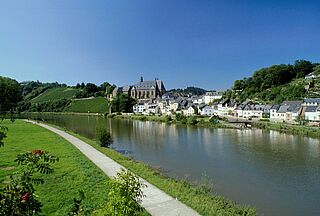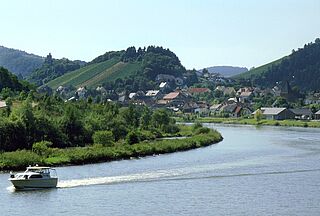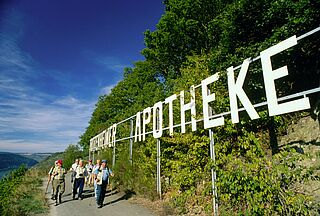Koenig Johann Berg
Kendte vinmarker
König Johann Berg - Blind, Bohemian King from Luxembourg is Namesake of Saar Vineyard Site
Viticulture in the Saar River Valley dates from Roman times. The top sites are extremely steep; consist primarily of stony, weathered slate; and are planted with Riesling grapes. Compared with their Mosel counterparts, young Saar Rieslings are often marked by an austere, steely acidity. The finest impart a taut balance of fruit and acidity and benefit from aging.
Vineyard statistics in recent years confirm that more and more steep vineyard sites – traditional features of the landscape in the Mosel-Saar-Ruwer, Ahr and Mittelrhein wine-growing regions – are being abandoned because they are so labor intensive and thus, too costly to cultivate. These sites are not only integral to the landscape, but also an important factor in regional tourism, a key source of income in these regions. To help preserve steep-site viticulture, growers who agree to maintain and/or replant steep sites can receive financial and technical assistance from rural agricultural service centers funded by the state.
This month’s famous site – König Johann Berg (literally, King John’s Hill) – is an example of an abandoned vineyard that is in the process of being reborn. It is situated south of Saarburg, on a steep hillside opposite the village of Serrig. Viticulture was first documented on this hill in the early 19th century, but given Serrig’s Roman viticultural heritage, it is not unreasonable to assume that vines were also cultivated on the opposite bank centuries ago. The ruins of a former owner’s house and winery (1905) at the foot of the vineyard are still standing. In recent years, the 6.5-ha/16-acre site had been owned by the Gales family, wine and sparkling wine merchants in Luxembourg, who virtually abandoned the vineyard. Adolf Schmitt, wine-grower and president of the Mosel wine-growers’ association, purchased the vineyard and the ruins in 2006.
New Ownership and Innovative Replanting
The ambitious plans of the Schmitt family (with daughter Andrea and son-in-law Michael Schnur-Schmitt) include replanting the abandoned hillside with Riesling vines in a future-oriented manner: Querterrassierung, or cross/ transverse terracing, whereby the vines are planted in horizontal rows on terraces at the foot of sloping embankments and are trained on wire trellises. In a conventional steep site, the vines are planted in vertical rows that sweep upward and are trained on single stakes.
Cross terracing can be implemented in sites with a gradient of up to 60 percent. In addition to being less prone to erosion, cross terracing affords the vines improved exposure (they don’t overshadow one another) and better circulation, which fosters ripeness and helps inhibit disease. The space between rows ranges from 1.6 to 2.2 meters – sufficiently wide for narrow-gauge tractors. Therefore, much vineyard maintenance can be done mechanically rather than manually and/or with the help of expensive cable traction equipment. In all, wine-growers have far less physical work in the vineyards and can use the same machinery in all their vineyards, whether flat, sloping or steep.
According to Franz-Josef Treis of the DLR Mosel (rural agricultural service center) and an expert on cross terracing, there are approximately 400 ha/988 acres of crossed terraced vineyards in Germany, three quarters of which are in the Ortenau district of Baden. In addition to the König Johann Berg, a few Mosel vineyards (in Pommern and the Koblenz suburb of Güls) have been replanted in this manner. While cross terracing is a promising means of conserving steep-site viticulture, it is expensive. Preparing a slope for replanting costs from €10,000 to €20,000 per hectare.
König Johann Berg was graded during the summer of 2006 and the Schmitt family is now in the process of planting the slopes with green cover. Because the site is ringed by a forest, the danger of damage by wild boars is a problem and thus, the Schmitts are installing a fence around the vineyard. The weathered slate soils of the site contain a considerable amount of loam. This enables them to retain water well and to yield grapes with a less austere acidity.There are also plans to renovate the former house/winery at the foot of the vineyard. It will be used as a tasting room. Riesling vines wlll be planted in spring of 2007 – first harvest will be 2010.
Origin of the Name
The heights of the König Johann Berg offer a fantastic view of the Saar Valley. No less spectacular is the view from the top of the neighboring hillside, a large sandstone plateau upon which a two-tory Klause (hermitage) was built in 1600. It was used as a retreat until the French Revolution, after which it fell into disrepair. In 1833, the heir to the Prussian throne, Friedrich Wilhelm IV, received the hermitage as a gift. He commissioned the architectural master of Berlin, Karl Friedrich Schinkel, to draw up plans to renovate the chapel as a funeral chapel for the blind König Johann of Bohemia, who stemmed from the House of Luxembourg – and namesake of the vineyard on the adjacent hillsiide.
The royal Prussian family thoroughly embraced the Romantic Movement that swept through Germany in the 19th century. Thanks to their interest in history and penchant for historical preservation, many a castle ruin in the Middle Rhine region was rebuilt in the 19th and early 20th centuries. The hermitage was also “saved” by the Prussians.
Friedrich Wilhelm IV was fascinated by the history of the Holy Roman Empire and particuarly taken by the fate of the blind king of Bohemia, Johann (1296–1346). Johann was the son of Heinrich VII of the House of Luxembourg, who was elected king of Germany in 1308 and crowned emperor of the Holy Roman Empire in 1312. He died a year later, but his son did not inherit the German crown – the seven electors opted for a weaker opponent – Ludwig of Bavaria. In 1310, however, the 14-year-old Johann had married Elisabeth of Bohemia (arragened by his father to foster a polical alliance between the House of Luxembourg and Bohemia) and was crowned king of Bohemia, a position he held until he died. In addition to his political successes in the east, he was known as a great horseman and jouster. In the 1830’s he lost his vision. Nevertheless, he remained active in politics until his death in the battle between the French and English in Crécy. Although Johann had fought on the side of the French, the Prince of Wales is said to have proclaimed on the battlefield: “There lies the Prince of Chivalry, but he does not die.” Johann’s loyalty to his alliance with France was regarded by the European aristocracy as the epitome of chivalry – with which Friedrich Wilhelm IV strongly identified.
Afternote: Johann’s son, Karl IV, did become king of Germany and emperor of the Holy Roman Empire...the positions his father never achieved.
Tips for Tourists:
Coming from Saarburg, to visit the König Johann Berg vineyard or the hermitage (in Kastel-Staadt), drive south to Krutweiler and watch for signs.
Hikers: From the Saar River to the vineyard is about a 15-minute walk. A hike from the vineyard to the hermitage (down a hill, brief walk along the riverbank, and then up a hill) takes about an hour and a half.
The hermitage is closed in December and January, Mondays, and from 1–2 p.m. In winter months it opens at 10 a.m and closes at 4 p.m.; in summer, from 9 a.m. to 5 or 6 p.m. Admission: €2,10. There are no guided tours, but English-language brochures are available.
What to see at the hermitage, built on a site that was a place for worship since at least 400 BC: the caves, niches and chambers carved into sandstone – dating from the 7th century, when the site was a Christian place of worship; the burial chapel and black marble sarcophagus designed by Schinkel (1833–1838). Remains of Roman baths in the vicinity of the hermitage.
Note: the remains of König Johann were transferred to the crypt of the cathedral of Luxembourg in 1946, although the sarcophagus remains on site in Kastel.
Many thanks to Michael Schnur-Schmitt, Weingut Ökonomierat A. Schmitt, and Franz-Josef Treis, DLR Mosel, for background information and illustrations.



